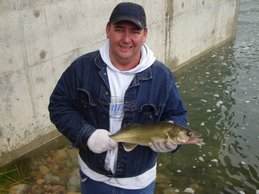Britannica Encyclopedia says
Sport of catching fish — freshwater or saltwater — typically with rod, line, and hook. Fishing is as old as the human ability to use tools to capture prey. The first significant modern innovations, including use of a reel, a rod with line guides, and a hook with an offset point, came in the late 17th and early 18th centuries. Horsehair was used as line until the mid 19th century, when it was replaced by textile materials; these in turn were replaced by nylon in the 1930s. Wood and bamboo rods yielded to rods of fibreglass and other synthetic materials. Forms of sport fishing practiced today include fly fishing (freshwater), in which a fly-like hook is repeatedly cast upon the water surface to attract biting fish; bait fishing (fresh- and saltwater), in which live or artificial bait is set or drawn below the surface; and big-game fishing (saltwater), in which heavy-duty tackle is used to land large marine species (including tuna, marlin, and swordfish) from a motorized boat.
I say
If you ever had a bad day fishing then you weren’t fishing.
Okay with this article my series on fishing officially gets under way. For all those veteran fisher people out there I am going right back to basics on this series. I want it to not only help the seasoned fisherman but I would love to see more women and children out there as well. So enough with the chit chat and let’s get down to business.
Fishing Gear Big And Small
You don’t need a lot of equipment to begin your fishing experience. In fact I would suggest keeping things simple to start with. You just want to make sure you can get your hook to the fish. Once you become a more avid fisher person you can move up and start investing in some more superior tackle. But for now the equipment at your local retail will be more than sufficient.
Fishing Pole
This is as basic as it gets. A fishing pole. Just about anything with about 5 feet of length could be used as a fishing pole. On a pole you don’t use a reel. You tie a piece of line on with a hook on the other. The line should be long enough to flip off a dock or over the edge of a boat. Split shot weights which are small round pieces of lead can be tied on a couple of inches above the hook to help the hook sink. Or in the reverse you can use a bobber which is usually a red and white plastic floating ball. This is usually used to keep your hook higher in the water for those fish that are feeding near the surface.
This technique is very rarely used any more but years ago on the prairies many a fish were caught using this form of fishing.
This will be the end of my first edition of my series on fishing. Keep reading my articles as they will get more informative and detailed as time goes on.
Dale Mazurek
Dale is an expert self taught fisherman of more than 35 years. He would like to share his expertise and stories with the world. You can check out his fishing blog at http://fishingtutor.blogspot.com. Dale is also a self taught author who is currently in the process of getting his first novel published. You can check his writings and lessons at http://stcajo-readshortstories.blogspot.com/
I am writing this for everyone young, old, big or small. The teachings in this series will range from novice to advanced. But I would just like everyone to remember that a bad day of fishing is better than a good day at work
Sponsors
Subscribe to:
Post Comments (Atom)




No comments:
Post a Comment